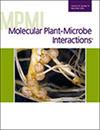Cellular Responses in the Pigeonpea Wild Relative Cajanus platycarpus to Helicoverpa armigera Herbivory: The Role of Methionine Sulfoxide Reductase B1 (CpMSRB1 ) in Enhanced Defense.
IF 3.4
3区 生物学
Q2 BIOCHEMISTRY & MOLECULAR BIOLOGY
Maniraj Rathinam, Narasimham Dokka, Kameshwaran Senthil, Shivangi Mahawar, Shaily Tyagi, Dineshkumar Rengarajan, Preethi Vijayaraghavareddy, Yuvaraj Iyyappan, Basavaraj Y B, Sandeep Reddy, Vinutha T, Rama Prashat G, Subodh Kumar Sinha, Prasanta K Dash, Sheshshayee Sreeman, Manoj Majee, Rohini Sreevathsa
求助PDF
{"title":"Cellular Responses in the Pigeonpea Wild Relative <i>Cajanus platycarpus</i> to <i>Helicoverpa armigera</i> Herbivory: The Role of Methionine Sulfoxide Reductase B1 (<i>CpMSRB1</i>) in Enhanced Defense.","authors":"Maniraj Rathinam, Narasimham Dokka, Kameshwaran Senthil, Shivangi Mahawar, Shaily Tyagi, Dineshkumar Rengarajan, Preethi Vijayaraghavareddy, Yuvaraj Iyyappan, Basavaraj Y B, Sandeep Reddy, Vinutha T, Rama Prashat G, Subodh Kumar Sinha, Prasanta K Dash, Sheshshayee Sreeman, Manoj Majee, Rohini Sreevathsa","doi":"10.1094/MPMI-11-24-0149-R","DOIUrl":null,"url":null,"abstract":"<p><p>Understanding key cellular mechanisms leading to improved defense against various stressors is essential for cultivating robust nutritious crops capable of flourishing in diverse environments. We present an in-depth characterization of the defense response in the pigeonpea wild relative <i>Cajanus platycarpus</i> to herbivory by pod borer <i>Helicoverpa armigera.</i> To fight the attacking pest, <i>C. platycarpus</i> strategically activated non-enzymatic reactive oxygen species (ROS) scavengers and unleashed methionine sulfoxide reductases to safeguard the integrity of methionine residues. We unveiled for the first time physical interaction between <i>Cp</i>MSRB1 and chorismate mutase (<i>Cp</i>CM1.1), a pivotal player in the phenylpropanoid pathway. This association fueled the synthesis of phenylpropanoids and enhanced ROS scavenging crucial for repelling herbivores. Repairing <i>Cp</i>CM1.1 also boosted salicylic acid production, coordinating defense signaling with jasmonic acid. Additionally, heterologous expression of <i>CpMSRB1</i> in tomato improved defense against herbivory by enhanced ROS scavenging and polyphenol production. This study demonstrates the role of <i>Cp</i>MSRB1 in protecting a major enzyme in the shikimate pathway, reinforcing defense against <i>H. armigera</i>. [Formula: see text] Copyright © 2025 The Author(s). This is an open access article distributed under the CC BY-NC-ND 4.0 International license.</p>","PeriodicalId":19009,"journal":{"name":"Molecular Plant-microbe Interactions","volume":" ","pages":"MPMI11240149R"},"PeriodicalIF":3.4000,"publicationDate":"2025-09-04","publicationTypes":"Journal Article","fieldsOfStudy":null,"isOpenAccess":false,"openAccessPdf":"","citationCount":"0","resultStr":null,"platform":"Semanticscholar","paperid":null,"PeriodicalName":"Molecular Plant-microbe Interactions","FirstCategoryId":"99","ListUrlMain":"https://doi.org/10.1094/MPMI-11-24-0149-R","RegionNum":3,"RegionCategory":"生物学","ArticlePicture":[],"TitleCN":null,"AbstractTextCN":null,"PMCID":null,"EPubDate":"","PubModel":"","JCR":"Q2","JCRName":"BIOCHEMISTRY & MOLECULAR BIOLOGY","Score":null,"Total":0}
引用次数: 0
引用
批量引用
Abstract
Understanding key cellular mechanisms leading to improved defense against various stressors is essential for cultivating robust nutritious crops capable of flourishing in diverse environments. We present an in-depth characterization of the defense response in the pigeonpea wild relative Cajanus platycarpus to herbivory by pod borer Helicoverpa armigera. To fight the attacking pest, C. platycarpus strategically activated non-enzymatic reactive oxygen species (ROS) scavengers and unleashed methionine sulfoxide reductases to safeguard the integrity of methionine residues. We unveiled for the first time physical interaction between Cp MSRB1 and chorismate mutase (Cp CM1.1), a pivotal player in the phenylpropanoid pathway. This association fueled the synthesis of phenylpropanoids and enhanced ROS scavenging crucial for repelling herbivores. Repairing Cp CM1.1 also boosted salicylic acid production, coordinating defense signaling with jasmonic acid. Additionally, heterologous expression of CpMSRB1 in tomato improved defense against herbivory by enhanced ROS scavenging and polyphenol production. This study demonstrates the role of Cp MSRB1 in protecting a major enzyme in the shikimate pathway, reinforcing defense against H. armigera . [Formula: see text] Copyright © 2025 The Author(s). This is an open access article distributed under the CC BY-NC-ND 4.0 International license.
野生种鸭嘴蝉对棉铃虫的细胞反应:蛋氨酸亚砜还原酶B1 (CpMSRB1)在增强防御中的作用
了解关键的细胞机制,从而提高对各种应激源的防御能力,对于培育能够在各种环境中茁壮成长的营养丰富的作物至关重要。我们提出了一个深入表征的防御反应在野生种鸽子,Cajanus platycarpus,对食草的荚螟,Helicoverpa armigera。为了对抗这种害虫,桔树策略性地激活非酶促活性氧清除剂,释放蛋氨酸亚砜还原酶(MSRs),以保护蛋氨酸残基的完整性。我们首次揭示了CpMSRB1和choris酸突变酶(CpCM1.1)之间的物理相互作用,CpCM1.1是苯丙素途径(PP)的关键参与者。这种关联促进了苯丙素的合成,增强了对排斥食草动物至关重要的活性氧清除能力。修复CpCM1.1也促进了水杨酸(SA)的产生,与茉莉酸(JA)协调防御信号。此外,CpMSRB1在番茄中的异源表达通过增强活性氧清除能力和多酚的产生来提高对草食的防御能力。该研究证明了CpMSRB1在莽草酸途径中保护一种主要酶的作用,增强了对棉蚜的防御。
本文章由计算机程序翻译,如有差异,请以英文原文为准。
来源期刊
期刊介绍:
Molecular Plant-Microbe Interactions® (MPMI) publishes fundamental and advanced applied research on the genetics, genomics, molecular biology, biochemistry, and biophysics of pathological, symbiotic, and associative interactions of microbes, insects, nematodes, or parasitic plants with plants.

 求助内容:
求助内容: 应助结果提醒方式:
应助结果提醒方式:


